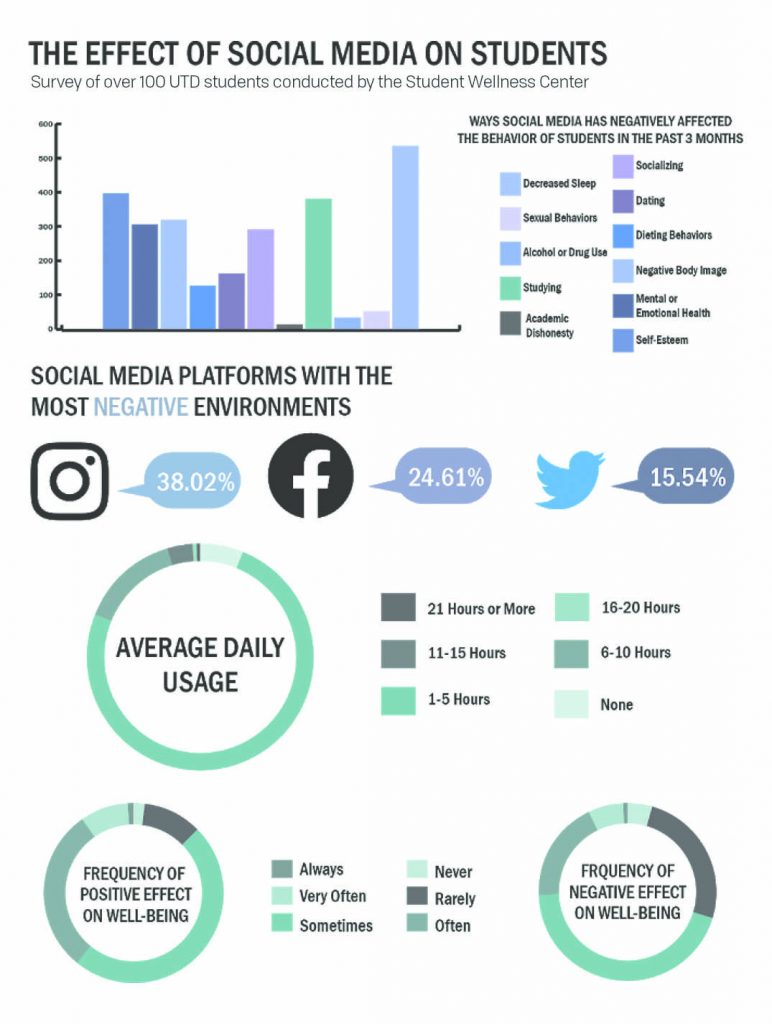On a typical weekday, psychology freshman Isa Hernandez finishes her homework at around midnight, and then uses Instagram and Twitter for about an hour before going to bed. Like other UTD students, she may experience lower self-esteem and lose sleep due to social media use.
A fall 2018 Student Wellness Center survey of over 1,000 UTD students found that 75% of respondents spend one to five hours on social media per day.
Hernandez said she has always used social media very little, and uses it after her academic work is completed. She said one of the negative effects of social media for her was negative body image and a small amount of self-esteem issues.
“I think it’s the type of people that everyone wants to be, like those travel bloggers and stuff, that everyone follows and wants to be. I think that would be the main cause of those negative effects,” Hernandez said. “On social media I tend to be a little bit more stressed, tense almost.”
In the survey, 20% of respondents said social media use interfered with sleep and 15% said it negatively impacted their self-esteem. When she has more time, journaling and painting are two activities Hernandez said she does in place of using social media. She has been journaling for six to seven years.
“It’s mostly for me about coping mechanisms and how you deal with negative self-image generally, not just with social media,” Hernandez said. “I have less anxiety and less stress for sure when I’m doing things that are not social media.”
To prevent distraction while studying, Herandez uses an app called Pocket Points which earns the user points for staying off their phone for allotted time blocks. Those points can then be cashed in for coupons from clothing stores and food brands.
“I like to do mine in hour chunks or if I feel like I really can’t concentrate really well then 30-45-minute chunks,” Hernandez said.
Business administration freshman Taylor Vaughan said she uses Instagram and Snapchat. She has been using Snapchat since 2013 and Instagram since 2012. She said she spends three hours daily on social media: an hour on Instagram and two hours on Snapchat.
“Sometimes it’s overwhelming to constantly be checking it, and there’s just always that pressure to look the best, act the best and be the best,” Vaughn said. “Also, a big thing is time, because if I’m spending that much time on social media, I’m not having enough time for other things.”
Survey respondents chose Instagram as the most negative social media platform, with 38% saying it had the biggest impact on users. Vaughn said the negative effects of her social media impact her studying and academic success as well as the amount of sleep she gets. She said she utilizes screen time on her phone to set limits, particularly at night when she needs to go to bed.
Computer Science freshman Kamden Wilson said he spends approximately three hours per day on social media: about an hour and a half on Snapchat, an hour on Twitter and then about 30 minutes on Youtube and other platforms. Wilson said he does not use Instagram, but Snapchat appeals to him because it contains his group chats and is how he talks to his friends
“I don’t really keep up with streaks anymore…there just wasn’t really a point,” Wilson said. “If I wanted to talk to somebody I don’t need to consistently send a picture every day, and if you’re keeping a streak with a random person, it’s not really genuine.”
Of nine different media platforms, Snapchat was voted as having the fourth most negative environment/impact on users, according to the Student Wellness Center Survey. Twitter took third place, with 15% of respondents choosing it as the most negative platform.
Hernandez said she uses Twitter mostly for news, and gets about 60% of her news from Twitter and 40% from other news sources.
“I think social media informs my political opinions a little bit, but I like to be educated on that kind of stuff,” Hernandez said. “So I read a lot from a lot of different sources because everyone is going to look at it differently.”
Vaughn said she usually hears about social issues on Instagram.
“I don’t read the news or anything, but if certain things come up usually people post about it,” Vaughn said. “And if there’s news for organizations I’m in, those will be on Instagram.”
Kacey Sebeniecher, the Director of the Student Wellness Center, encourages students to use social media in moderation.
“Know when to disengage, when its not healthy for you,” Sebeniecher said. “Make those boundaries for yourself that I am only going to engage in something positive, and if it becomes too negative for me then I’m just going to take a break.”

Leave a Reply